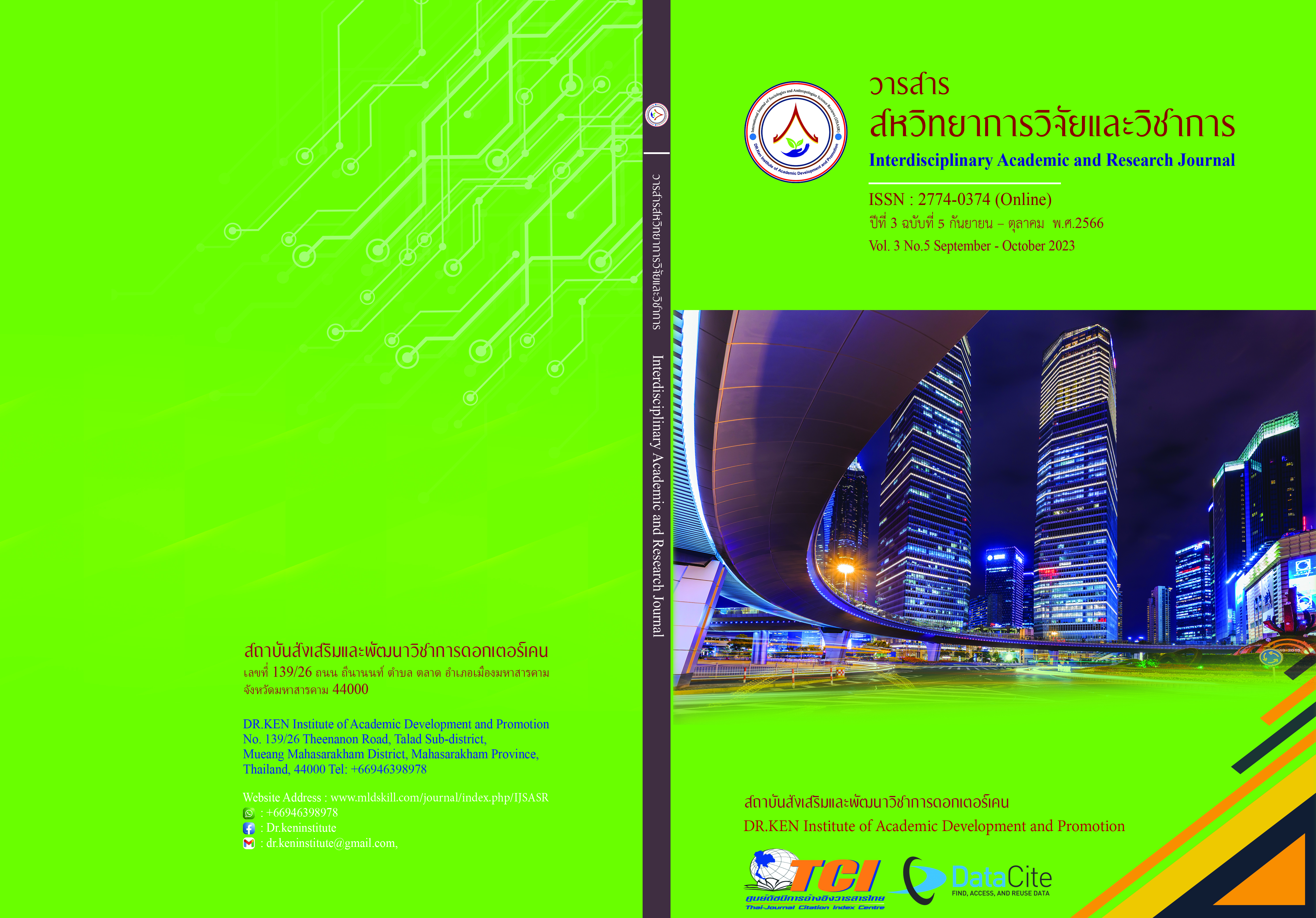The Development of Problem-Solving Ability, Academic Achievement, and Attitude toward Science Using Flipped Classroom Approach of 1oth Grade Student
DOI:
https://doi.org/10.14456/iarj.2023.267Keywords:
Flipped Classroom; , Ability to Solve Scientific Problems; , Attitude towards ScienceAbstract
The ability to solve scientific problems is a cognitive ability that relies on a person's brain processes, and various complex behaviors resulting from intellectual development to identify and act in a systematic way to solve scientific problems. The objectives of this research study were 1) to compare the scientific problem-solving ability of 10th-grade students between before and after learning via the flipped classroom learning management, 2) to compare learning achievements on Genetic Mutation of the students with the 70 percent criteria, and 3) to study attitudes towards the science of 10th-grade students learned via the flipped classroom learning management. The sample group was a classroom of 38 students from one of the provincial schools in Maha Sarakham Province gained from the Cluster Random Sampling technique. The research tools consisted of 1) 6 plans 12 hours of flipped classroom learning management is appropriate at the highest level. the four multiple-choices of Scientific Problem-Solving Ability Test for 3 situations, 12 items, with a discrimination index between 0.23-0.69 and a reliability of 0.75, 3) the four multiple-choices Academic Achievement Test for 30 items with difficulty between 0.20-0.75, discrimination index between 0.21-0.89 reliability of 0.91, and 4) the Attitude Towards Science Questionnaire consisting of 15 items with the discrimination index between 0.24-0.55 and reliability of 0.82. The data analysis statistics were mean and standard deviation. Statistics used to test hypotheses were a t-test for the dependent sample and a t-test for one sample. The results showed that after learning via the flipped classroom learning management the students showed 1) problem-solving ability statistically higher than those before learning at a significant difference of .05 level, 2) academic achievement statistically higher than the 70 percent criteria at a significant difference of .05 level; and 3) the overall attitude toward science at a high level.
References
กระทรวงศึกษาธิการ. (2562). นโยบายการจัดการศึกษาของกระทรวงศึกษาธิการ ปีงบประมาณ พ.ศ.2563. Retrieved on April 28, 2022 from: https://www.bkkedu.in.th/wpcontent/uploads/2020/04-2563.pdf
จินตนา แก้วอาสา. (2564). การจัดการเรียนรู้แบบห้องเรียนกลับด้าน เพื่อส่งเสริมการคิดวิเคราะห์ และเจตคติเชิงวิทยาศาสตร์สำหรับนักเรียนชั้นประถมศึกษาปีที่ 4. วิทยานิพนธ์ปริญญามหาบัณฑิต: มหาวิทยาลัยราชภัฏมหาสารคาม.
จินตนา ธนวิบูลย์ชัย. (2552). การคิด การคิดแก้ปัญหา และการตัดสินใจ. กรุงเทพฯ: มหาวิทยาลัยสุโขทัยธรรมมาธิราช.
ชบาพร พิมวัน. (2562). การจัดการเรียนรู้แบบห้องเรียนกลับด้านร่วมกับสืบเสาะหาความรู้ (5E) ที่ส่งเสริมทักษะการคิดวิเคราะห์และผลสัมฤทธิ์ทางการเรียน เรื่อง สมบัติของสารพันธุกรรมและมิวเทชันของนักเรียนชั้นมัธยมศึกษาปีที่ 6. วิทยานิพนธ์ปริญญามหาบัณฑิต: มหาวิทยาลัยราชภัฏมหาสารคาม.
พรรณวิไล ชมชิด. (2557). พฤติกรรมการสอนวิทยาศาสตร์. มหาสารคาม: ตักสิลาการพิมพ์.
เพ็ชรรัตน์ เวฬุคามกุล และวราวุฒิ พุทธให้. (2555). การออกแบบและพัฒนาบทเรียนคอมพิวเตอร์ช่วยสอน วิชาหลักชีววิทยา เรื่องการแบ่งเซลล์. วิทยานิพนธ์ครุศาสตรมหาบัณฑิต: มหาวิทยาลัยเทคโนโลยีราชมงคลพระนคร.
วันเฉลิม อุดมทวี. (2557). การพัฒนาความสามารถการคิดเชิงบูรณาการและผลสัมฤทธิ์ทางการเรียนของนักเรียนชั้นมัธยมศึกษาปีที่ 3 โดยใช้รูปแบบการเรียนรู้แบบใช้ปัญหาเป็นฐานร่วมกับเทคนิคห้องเรียนกลับทาง. วารสารศึกษาศาสตร์ มหาวิทยาลัยขอนแก่น, 37(1), 125-132.
วิจารณ์ พานิช. (2556). ครูเพื่อศิษย์สร้างห้องเรียนกลับทาง. พิมพ์ครั้งที่ 2. กรุงเทพฯ: เอสอาร์พริ้นติ้ง แมสโปรดักส์.
สถาบันทดสอบทางการศึกษาแห่งชาติ. (2565). รายงานผล O-NET ด้วยแผนที่ประเทศไทย. Retrieved on 28 April 2022 from: https://www.niets.or.th/th/catalog/view/3121.
สถาบันส่งเสริมการสอนวิทยาศาสตร์และเทคโนโลยี. (2555). ทักษะและกระบวนการทางคณิตศาสตร์. (พิมพ์ครั้งที่ 3). กรุงเทพมหานคร : โรงพิมพ์ 3-คิวมีเดียจำกัด.
สิริยากร ชาวนาฮี และกัญญารัตน์ โคจร. (2564). การพัฒนาการจัดกิจกรรมการเรียนรู้โดยใช้ปัญหาเป็นฐานร่วมกับแนวคิดห้องเรียนกลับด้าน เพื่อส่งเสริมผลสัมฤทธิ์ทางการเรียนวิชาฟิสิกส์และความสามารถในการคิดแก้ปัญหาของนักเรียนชั้นมัธยมศึกษาปีที่ 4. Rajabhat MahaSarakham University Journal, 15(2), 210-218.
สิริราช ถูกดี และพรรณวิไล ดอกไม้ (2565). การจัดการเรียนรู้แบบห้องเรียนกลับด้าน เพื่อส่งเสริมการแก้ปัญหาทางวิทยาศาสตร์และความพึงพอใจในการเรียน เรื่อง ระบบอวัยวะในร่างกายเราสำหรับผู้เรียนชั้นมัธยมศึกษาปีที่ 2. Rajabhat Maha Sarakham University Journal, 16(3), 270-280.
อุไรวรรณ มากพู; (2562). การพัฒนารูปแบบการจัดการเรียนรู้ตามแนวคิดห้องเรียนกลับด้าน (Flipped Classroom) เพื่อส่งเสริมความสามารถในการคิดวิเคราะห์กลุ่มสาระการเรียนรู้สังคมศึกษา ศาสนา และวัฒนธรรม ชั้นมัธยมศึกษาปีที่ 6. Journal of Educational Technology and Communications Faculty of Education Mahasarakham University, 6(2), 58-71.
Bergmann, J., & Sams, A. (2012). Flip Your Classroom: Reach Every Student in Every Class Every Day (pp. 120-190). Washington DC: International Society for Technology in Education.
Berrett, D. (2012). How 'Flipping' the Classroom Can Improve the Traditional Lecture. Chronicle of Higher Education.
Drysdale, J.S., Graham, C.R., Spring, K.J., & Halverson, L.R. (2013). An Analysis of Research Trends in Dissertations and Theses Studying Blended Learning. The Internet and Higher Education, 17, 90-100. http://dx.doi.org/10.1016/j.iheduc.2012.11.003
Klopfer, L.E. (1971). Individualized Science: Relevance for the 1970's. Science Education, 55(4), 441-448.
Weir, J.J. (1974). Problem-Solving Is Everybody’s Problem. Science Teacher. 41(4), 16-18.
Downloads
Published
How to Cite
Issue
Section
License
Copyright (c) 2023 Kanokwan Kumhla, Natchanok Jansawang

This work is licensed under a Creative Commons Attribution-NonCommercial-NoDerivatives 4.0 International License.
Copyright on any article in the Interdisciplinary Academic and Research Journal is retained by the author(s) under the under the Creative Commons Attribution-NonCommercial-NoDerivatives 4.0 International License. Permission to use text, content, images, etc. of publication. Any user to read, download, copy, distribute, print, search, or link to the full texts of articles, crawl them for indexing, pass them as data to software, or use them for any other lawful purpose. But do not use it for commercial use or with the intent to benefit any business.
















.png)


